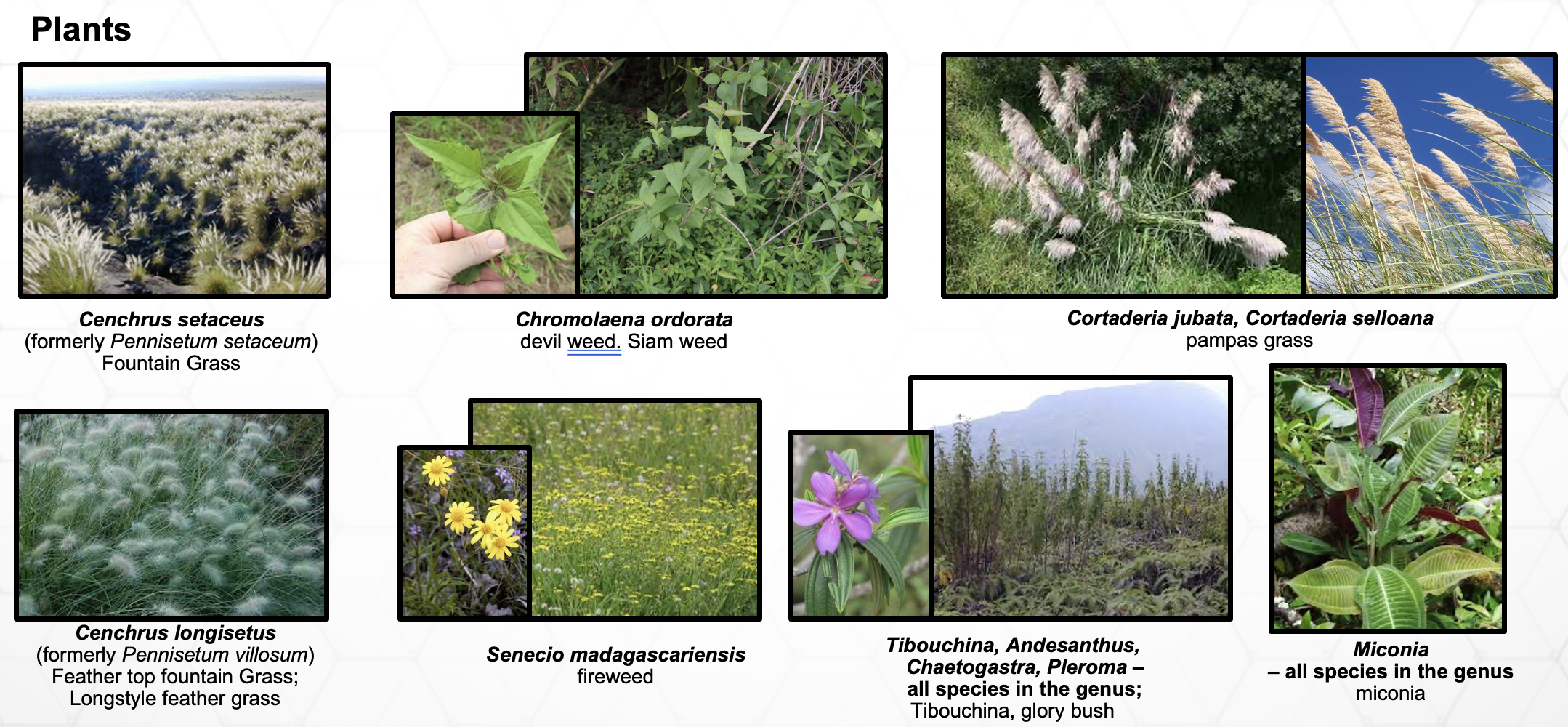HISC Administrative Rules
TITLE 13 OF SUBTITLE 14 HAWAII ADMINISTRATIVE RULES, INCLUDING CHAPTER 325, “GENERAL PROVISIONS,” AND CHAPTER 326, “CONTROL AND ERADICATION OF INVASIVE SPECIES”
Governor Josh Green signed the HISC Administrative Rules on March 17, 2025 that creates the new Title 13 of Subtitle 14 of Hawaii Administrative Rules, including Chapter 325, “General Provisions,” and Chapter 326, “Control and Eradication of the Invasive Species.” A summary of the rules is provided below.
Final Rules – Unofficial Copy for reference
SUMMARY:
- Chapter 325 contains 3 sections that set out the general provisions as follows:
-
- Section 325-1 “Purpose” sets out that the purpose of the rules is to implement HISC authorities under chapter 194 HRS.
- Section 325-2 “Definitions” sets out the definitions for the subtitle.
- Section 325-3 “Relationship to other laws” clarifies that the proposed rules may not be construed to limit existing authorities.
- Chapter 326 contains 6 sections that are related to the authority of HISC departments, the counties, and their agents to carry out actions to control or eradicate invasive species identified by the HISC, as follows:
-
- Section 326-1 “Invasive species identified by the council for control or eradication” sets out the list of invasive species identified by HISC for control or eradication (identified species).
- Section 326-2 “Requirements for control or eradication on private property” sets out the requirements for a HISC department or country or an agent to control or eradicate an identified species on private property.
- Section 326-3 “Notice” sets out the requirements for notice to a private property owner, or tenant or occupant, before control or eradication actions may be carried out on the private property.
- Section 326-4 “Requirement for control or eradication by private property owner” authorizes a HISC department or county or their agent to order a private property owner to control or eradicate an identified species if the identified species was intentionally and knowingly established on the private property.
- Section 326-5 “Requirements for control or eradication on public property” sets out the requirements for a HISC department or its agent to order an entity in charge of State or county property to control or eradicate an identified species on the public property.
- Section 326-6 “Warrants” sets out the requirements for a HISC department or county to seek a warrant to carry out a control or eradication action on private or public property without the consent of the property owner, tenant, occupier, or entity in charge, as appropriate.
Background
In 2003, HISC was established in statute by the enactment of Act 85. That law, as amended, is set out in chapter 194, HRS. The law sets out the duties and membership of the HISC. It also requires HISC to identify invasive species “for control or eradication.” HRS §§ 194-4, 194-5. Once HISC identifies those invasive species, chapter 194 HRS authorizes the departments of the HISC, the counties, and their agents to control or eradicate those invasive species on private property and the departments of the HISC and their agents to control or eradicate those invasive species on public property. HRS §§194-5, 194-6. HISC is required to adopt administrative rules that list the invasive species identified for control or eradication and set out procedures for the control and eradication actions. HISC has not previously adopted any administrative rules.
In 2022, HISC staff, in consultation with the Department of the Attorney General, began the process of drafting administrative rules to carry out chapter 194, HRS, in accordance with chapter 91, HRS. These rules focus on a list of invasive species identified by HISC for control or eradication; procedures for HISC departments, the counties, or their agents to carry out control or eradicate actions for those species on private property; and for HISC departments and their agents to carry out control or eradication actions on State or county property. The proposed rules where considered by HISC at a noticed, public meeting on May 29, 2024. At that meeting, HISC unanimously voted to initiate the rulemaking process for the proposed rules. The rules were considered by the by Small Business Regulatory Review Board on June 20, 2024, and approved to move forward to public hearing. A public hearing was scheduled on September 25, 2024 and minor changes were made to the list of species based on testimony. The final rules were signed by the Governor on March 17, 2025.
Purpose of the Rules
High-impact invasive species continue to be detected and spread across the State. After ten years of containment to Oʻahu, the coconut rhinoceros beetle was detected on Kauaʻi in the summer of 2023. Soon after, new detections were found on Maui and Hawaiʻi Island of the same year. The little fire ant continues to spread throughout the counties with particular concern for Oʻahu where infestations, particularly on the windward side have drastically increased with over 30 active sites as of May 2024. The Island Invasive Species Committees (ISCs) on Oʻahu and Kauaʻi have prevented invasive plants like Miconia from taking over forested watersheds with ongoing, dedicated control efforts
Proposed List of Invasive Species Identified for Control or Eradication
The species listed as invasive species identified by HISC for control or eradication are the highest impact invasive species that are continuing to spread within the State or that would require an immediate response if found in the State. A description of each species selected is as follows:


